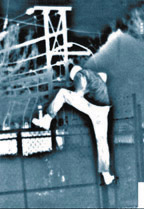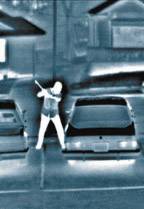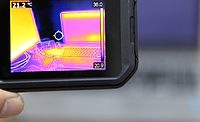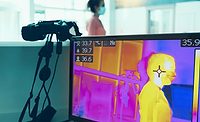Protecting Borders with Thermal Imaging
With a jurisdiction of 10,000 square miles, including 120 miles of border between Arizona and Mexico, the Pima County Sheriff's Department has a big responsibility. But infrared thermal imaging technology is giving the department a new way to cover all that ground.
Deployed during a nighttime drug smuggling surveillance effort, thermal imaging technology helped officers easily spot suspects crossing the border, with drugs stuffed in their backpacks. In the first four nights of using the technology, officers returned with suspects and confiscated drugs every night.
Infrared (IR) thermal imaging cameras provide another set of eyes for border control professionals and help them meet the demands they face at night and in other low-light situations. IR cameras detect the invisible infrared energy that all people and objects emit, and can "see" better than the naked eye at night and in bad weather. Whether searching for a fugitive or performing a special surveillance operation or routine patrol, darkness can be the greatest obstacle to border control professionals.
Infrared thermal imaging cameras equip border control personnel with a whole new way of looking at the world. In simplest terms, thermal imagers operate like the human eye, but they are much more powerful. Energy from the environment comes through a lens and is registered on a detector. In the case of the infrared thermal imager, that energy is heat rather than light. By measuring very small relative temperature differences, invisible heat patterns are converted by the thermal imager into clear, visible images that the human eye can see through a viewfinder or TV monitor.
All objects that are not at absolute zero temperature (0 degrees K or -459.67 degrees F) emit various types of electromagnetic radiation including infrared. The hotter an object gets, the more infrared radiation is emitted as a result of the thermal agitation of its molecules and atoms. The spectral distribution or wavelength of this energy depends on the nature of object (i.e. its relative effectiveness as a radiator, called emissivity) and upon its temperature. Blacker colors and duller surfaces usually have a higher emissivity and radiate infrared energy more effectively. Lighter colors and shinier surfaces radiate less effectively.
Because the energy being sensed is heat and not light, thermal imagers can be used in both daytime and nighttime operations to find people, avoid obstacles or detect fire hot spots. Due to their own levels of infrared heat energy, people are easily seen 24 hours a day. Thermal imagers are usually very sensitive and can detect temperature variations as small as 0.1 degrees centigrade, even in less than ideal environmental conditions. Since they are unaffected by the amount of light in a scene, they won't "bloom" or shut down in direct light.

Thermal Imaging vs. Image Intensification
While the term "night vision" often applies to both thermal imaging and image intensification, there is a difference. Image intensification devices operate by amplifying available light thousands of times to create an apparent pseudo-daytime image. Because image intensification devices rely on available light, but cannot tolerate too much light, they are often ineffective in very low-light conditions and in normal or bright conditions. They also require a certain level of visual contrast to distinguish objects in a scene. People hidden by shadows or foliage and objects of a similar color that may blend together can become indistinguishable when viewed by some devices.
Thermal imaging offers advantages over image intensification devices. Although thermal imagers sometime lack the fine resolution of image intensification devices and will not see through glass, thermal imagers provide a more detailed image under typical field conditions. While fog and other forms of precipitation do degrade infrared images, thermal imagers can see through dust, clouds, smoke, haze, light fog, light rain and most camouflage, while I2 systems cannot. Thermal imagers often see their targets at much longer ranges than devices relying on image intensification. With the detection ranges of thermal imaging systems being dependent on object size and thermal contrast, current-day handheld systems often see man-sized targets at ranges of 1/2 mile or more, and larger objects out to several miles. Thermal imagers are unaffected when viewing bright lights.

Surveillance and Border Protection
With its ability to operate night or day, "see" through foliage and can be used in various weather conditions, infrared thermal imagers can be used in a variety of surveillance and border control situations.Cross-border and perimeter surveillance: In manhunt or crisis situations, one of the first operational actions is to set up a perimeter. Handheld or vehicle-mounted thermal imagers can make this perimeter more effective in containing and apprehending suspects or detecting and preventing unwanted intruders from invading a restricted area. Highly restricted facilities, such as correctional institutions or industrial plants, can monitor their perimeters night and day with the aid of a thermal imager.
Fugitive Searches: Thermal imagers are excellent at finding people hiding in foliage, regardless of the time of day. By locating a fugitive with a thermal imager, officers can approach and apprehend a suspect without giving away their own location or risking dangerous confrontations. Blind sweeps involving many officers are not needed.
Routine Patrols: The greatest benefit of a thermal imager is the ability to see in darkness. This provides a tremendous advantage during routine patrols and special surveillance missions. Thermal imagers are effective tools in locating discarded contraband or evidence, during undercover stakeout operations or during narcotics interdiction. On the water, thermal imagers are used for nighttime navigation, to locate and track vessels and for search and rescue operations. The passive nature of thermal imaging allows investigators to conduct surveillance undetected and without violating citizens' rights of privacy.
Tactical Support: Officers are aware of how image intensifiers can help snipers make positive facial identification under the right conditions. Infrared thermal imagers can be used in conjunction with image intensifiers. For example, a spotter can use a FLIR device for detection purposes in situations where there are multiple offenders (e.g. in a hostage situation) and prioritize targets. Prior to a nighttime narcotics search, scouts can use thermal imagers to better survey the scene and make better decisions about personnel deployment and the best point of entry.
According to one border officer patrolling the U.S./Mexico border in Texas, thermal imaging cameras not only increase apprehensions, they reduce the strain on manpower. The units are particularly effective in freight train yards, where illegal aliens attempt crossings by stowing away in vehicles carried on the freight trains. Before acquiring thermal imaging cameras, patrol officers had to manually check each compartment with trained dogs, which proved to be a drain of time and resources. The thermal imagers simplify surveillance efforts in the train yards and along the Rio Grande, where aliens hide in dense brush and foliage along the river.
By integrating the cameras with video motion detection (VMD) technology, officials can view the data from the cameras in real-time and immediately discriminate between threats and non-threats. If border officials determine there is a threat in the "sterile zone" or other area, they can instantly relay an alarm. Automatic VMD systems on the market today can also do the watching for large or small networks of cameras, and alert an operator of an intrusion.
In night security applications, this kind of visual assessment is difficult without lights. Thermal imaging has unique benefits in "lights-out" settings where illuminating an entire area may draw unwanted attention to a border or facility. Lighting an area at night can also create "shadow cover" for intruders, compared with a thermal imaging camera that can detect people hidden by shadows.
For security applications, infrared thermal imaging cameras can be a cost-effective alternative to the installation, usage and maintenance of lighting systems used to safeguard borders as well as corporate facilities, factories and warehouses, expensive residential property and governmental sites.
Infrared thermal imaging technology has come a long way since its days in the military. Today, the cameras are effective tools in border patrol, law enforcement and fire fighting. The widespread adoption of the technology has made thermal imaging more accessible to departments looking to improve surveillance efforts and provide added protection to officers and agents. Whether used as a stand-alone device or as part of a larger, integrated system, thermal imaging cameras are an essential part of safety arsenals around the world.
Unraveling the Myths
1. Can thermal imaging cameras really see through walls?No. The cameras only "see" heat as it radiates off an object. It may see the heat coming from a house, but it can't see into the house because the camera picks up the house's exterior thermal profile first. The thermal imager doesn't even see through glass, because glass has its own thermal profile.
2. Can it see through clothes?
Not really. If a suspect had a gun under his/her coat, the exterior area of the coat would appear "cooler" to the camera and indicate to the police the person may be carrying a gun.
4. How is law enforcement using this technology?
o Officer Safety: locates threats such as hidden suspects, guard dogs and dangerous obstacles;
o Search and Rescue: vision at night; covers large areas quickly and with less manpower; and
o Vehicle Pursuits: see vehicles driving without headlights from the air; detects heat of recently-driven vehicles in crowded parking lot or remote area.
- Edited by John Mesenbrink, with contributions from Doug Van Dover, Raytheon's Sales Manager.
SIDEBAR:
1. Can thermal imaging cameras really see through walls?No. The cameras only "see" heat as it radiates off an object. It may see the heat coming from a house, but it can't see into the house because the camera picks up the house's exterior thermal profile first. The thermal imager doesn't even see through glass, because glass has its own thermal profile.
2. Can it see through clothes?
Not really. If a suspect had a gun under his/her coat, the exterior area of the coat would appear "cooler" to the camera and indicate to the police the person may be carrying a gun.
4. How is law enforcement using this technology?
o Officer Safety: locates threats such as hidden suspects, guard dogs and dangerous obstacles;
o Search and Rescue: vision at night; covers large areas quickly and with less manpower; and
o Vehicle Pursuits: see vehicles driving without headlights from the air; detects heat of recently-driven vehicles in crowded parking lot or remote area. - Edited by John Mesenbrink, with contributions from Doug Van Dover, Raytheon's Sales Manager
Looking for a reprint of this article?
From high-res PDFs to custom plaques, order your copy today!







